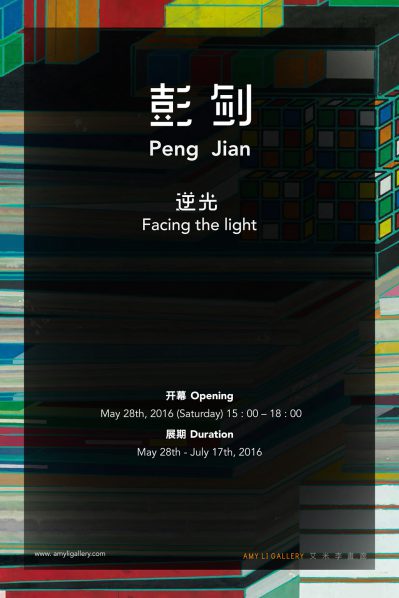
Facing the Light: Peng Jian Solo Exhibition
Opening: 2016.5.28 from 15:00 to 18:00
Duration: 2016.5.28 – 7.17
Address: Amy Li Gallery ( No.54 Caochangdi, Chaoyang District, Beijing 100015, China)
The new ink artist Peng Jian will present his most recent works in his exhibition Facing the Light at Amy Li Gallery from May 28th 2016. The exhibition is conceived as the first collaboration between the artist and Amy Li Gallery, in which the majority of the twelve exhibited works is created earlier this year for this very occasion; that is to say, the exhibited works represent exactly the current conception and progress of artist. The ambition of Facing the Light is to invite viewers into an erudite world surrounded by books and images of things, founded by the artist Peng Jian himself, enwrapped by series of unpredictable surprises and moments of sudden insights.
Born in Hunan province, Peng Jian graduated from the Chinese Painting Department of the China Academy of Art, currently lives and works in Hang Zhou. Partly because he has lived aboard for a time with his family, Peng Jian had more chance than his peers to embrace the occidental traditions. This natural encounter between Orient and Occident happened early in his youth and opened his artistic practices towards a broader horizon where the occidental speculative thinking meets the Zen's “void”, leading the artist to form a personal style sharing a close relation with the Mono-ha tradition. The origin of Mono-ha traces back to the late 60s art scene in Japan, which concentrates on the way of "seeing things" in their proper state of being or in combination with one another. The way Mono-ha artists elaborated and observed things is to combine every perceptible thing freely by ignoring all paradigms of conventions or of structures, leaving them aligned, stacked or scattered in unaltered and unprocessed states. This contemplating and intuitive art tradition, based over analytic practices and observations of things' inner relations, also influenced the artist’s seemly more consistent painting practice over its arrangement of pictorial space, its multiplication of vision and extended textual order. Instead of pointing to the specific tangible things or any empiricism, the exhibition title Facing the light refers to a multiple and even infinite propositions of art and its presuming orders. Accordingly, this disenchanted depiction of the immanence of the thing offers us a more reflexive and introspective expression of it, which in return conveys the intellectual and spiritual ambitions of the artist who acts as a reflexive observer and a creator of text.

Peng Jian, Peep, 2016; Ink and Colour on Paper, 82x99cm
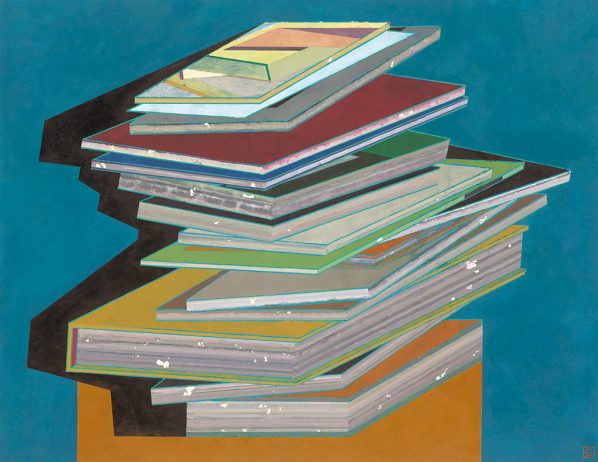
Peng Jian, Color (side), 2016; Ink and Colour on Paper, 58.5x75.5cm
Peng Jian seeks, in his own practice of Chinese ink art, something innovative and transformative bound to merge, within a delicately composed pictorial surface, the contemplation of the thing overwhelmed by its image in the Zen school tradition and the analytic conception of the thing reigning in the Occidental philosophical tradition. Moreover, the palette Peng Jian uses is more of a Japanese ukiyo-e style than an Occidental choice of paint. The ukiyo-e prints are well known for their contrast and vivid uses of color, among which the green and carmine combination has been most popular. By the same token, we can also identify the remarkable use of the almost saturated green, carmine or vermilion in Peng Jian's works, for whom the palette has gone far beyond the common harmonious operation of colors. In his paintings, colors and the choice of paint are the crucial elements, with the same essential role as the motifs and as the objects depicted. Furthermore, one's palette is more of a subjective way of expression in considering the random and autonomous quality of colors. For example, an irregular color lump in a composition can alter the original stable composition of the painted surface and serve for an extra outlet for personal and intimate feelings. The traditional measured painting skills (Jiehua in original language) which Peng Jian applies to his work converts the original surface to a transparent space, within which one can also identify the influence of Cubism and Structuralism. The most sophisticated delineation unveils advanced abstract thoughts deliberately led by the artist who is always determined to achieve a break-through in the traditional paradigms imposed by his own heritage. Efforts have been to evoke the actual being of the image of things and the potential narrative power of the ink art. Other than the social criticism in "The composition under rulers" where the composition are reined in by the threefold palette of black, white and grey, Peng Jian transposed the image surface to a phenomenological analysis with the work of "Gorgeous". The third dimension is later established with the most recent series "Facing the light" where the artist attempts to draw a new order between the Thing and the self, where the subjectivity is blown up to convey more imaginary spaces. In Peng Jian's own words, the series Facing the light should be understood "to preserve more possible failure, undecided and fugitive moment, and chaos of images", in a way that the presumably rigid pictorial language can make way for more textual significations or advanced analysis. Taking the Ten Miles Away as an example, books, Rubik's cube and toy blocks are the main components of the painting, perfectly delineated in a well-composed linear perspective which is as well an audacious lay-out of the vivid color palette. But all of these components construct a textual sphere other than the sheer concrete and semantic meaning of those three kinds of objects, which is the vibration between those objects. This vibrating and responding relations between the depicted objects are actually the central motif of this painting, they are both practical for the pictorial composition and metaphorical for the integrity of the work's meaning —— revealing the image-self dialectics implicated by the vibration between random conjunction of things, direct or indirect. The emphasized and blown-up details inside the image, as well as the perfectly ordered composition, the prudent but deliberately undecided choice of colors, all three elements above successively insert a dangerous, destructive and even violent game of hazard right into a seemingly accurate, balanced and ordered image space. Ten Miles Away as the working title explains itself the substantive distance between the objective seeing and the actual meaning, between the illusion and the reality.
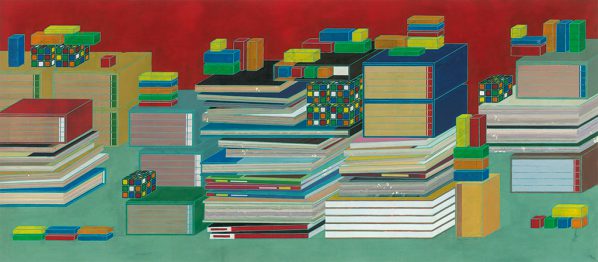
Peng Jian, 10 Miles Away, 2016; Ink and Colour on Paper, 80x183cm
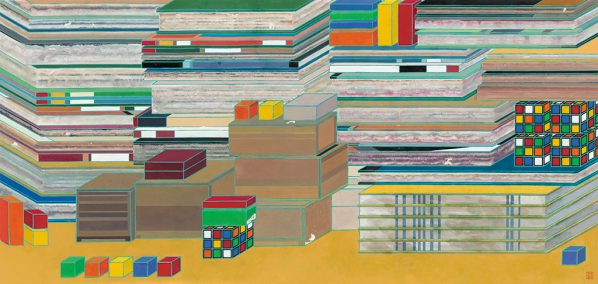
Peng Jian, Take Place, 2015; Ink and Colour on Paper, 58x124cm
Peng Jian is quite a minimalist in his life who gives natural attentions to details and holds onto the taste. Gourmandise, tea ceremony and art crafts collection are parts of his quotidian activities. Peng Jian rooted his profound sensations of things in the most ordinary randomness and coincidence, interpreting life and arts in a silent way by his own intimate and spiritual narratives.
Facing the light reveals the dynamic of Peng Jian's paintings, concealed from the statics of surface and the tranquility of lines. The minimalist conception of Peng Jian's works establishes the substantive and abstract relations behind the appearance of objects, which in return extends into a wider connotation of the very practice of painting itself where new possibilities vibrate in between the rational and the emotional sphere of the usual empirical analysis of the world of objects. The artist applies his introspective observation over "the Thing" and explores it with an intense meditative interest derived from Zen tradition. By discovering the very being of "the Thing", Peng Jian actually actuates the opening probabilities of the Ordinary and the Common sense and brings new points of view towards and from "the Thing", which all build up the force and the vivid relation between things and their images.Facing the Light will be on view from May 28 through July 17, 2016.
About the artist
Peng Jian2013 Graduated from China Academy of Art, Hangzhou, China1982 Born in Yueyang, Hunan Province, ChinaSolo Exhibitions2015 “Gorgeous”, Hadrien de Montferrand Gallery, Beijing, China2014 "The Composition under Rulers", Hive Center for Contemporary Art, Beijing, China2013 "Through the Windows", Galerie Ora-Ora, HongKong, China

Running in the Night: Sun Hao Solo Exhibition
Opening: May 28th, 2016 (Saturday) 15 : 00 – 18 : 00
Duration: May 28th - July 17th, 2016
Venue: Amy Li Gallery (No.54 Caochangdi, Chaoyang District)
On May 28th, in the summmer time of vitality, Amy Li Gallery welcomes the solo exhibition of a young ink painting artist Sun Hao "Running in the night". This is a complete presentation of his new and finest creations, which gives the audience the opportunity to understand more deeply the research directions and creative attitude of Sun Hao. In 2016 Amy Li Gallery will continue as before to explore new international forces, and to bring to the eyes of the Chinese public even more prominent artists.
The probing and introspection into ethnic culture is an instinctual drive in humanity’s quest for knowledge, one which has never ceased. In the rapid economic growth and constantly evolving commercial models of today’s China, culture is treated as a lagging force, one that must pick up its pace to keep up with the times, and must present old forms in new faces to maintain its youth. The exploration of the revival of literati painting traditions began long ago in the era of Xu Beihong. In the century since, the mainstream of this thread has always remained within the traditional flower-and-bird and shanshui landscape framework, while true renewal in the contemporary sense has remained a mirage. The ability to grasp and control the weight of tradition has always been the foundation for the path to innovation. The regional culture of the hometown of Confucius and Mencius has firmly rooted Sun Hao in orthodox tradition, but also planted the seeds of desire for renewal in his consciousness. Sun Hao studied first at the Lu Xun Academy of Fine Arts Chinese Painting Department, and subsequently moved to the Central Academy of Fine Arts. This shift in region kindled a strong sense of the changing times. Having studied painting from a young age, Sun had strong skills rooted into his physical memory, which were sparked by the inspiration of his teacher Hu Wei, and two other mentors Fang Xinquan and Chu Jingye.
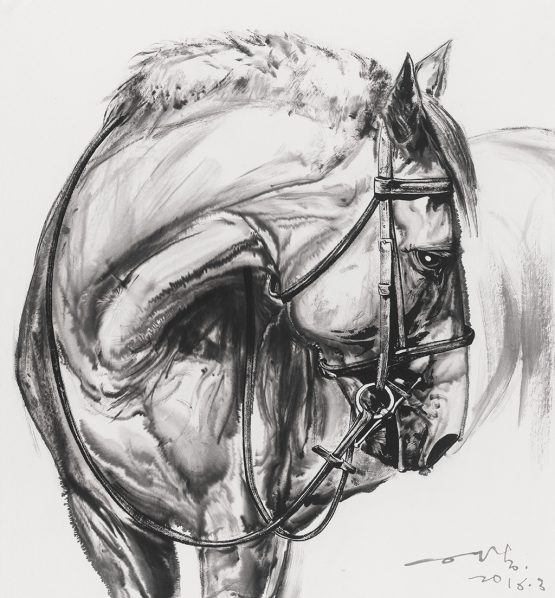
Sun Hao, Portrait of the Horse No.1, 2016; Ink on paper, 97x90cm
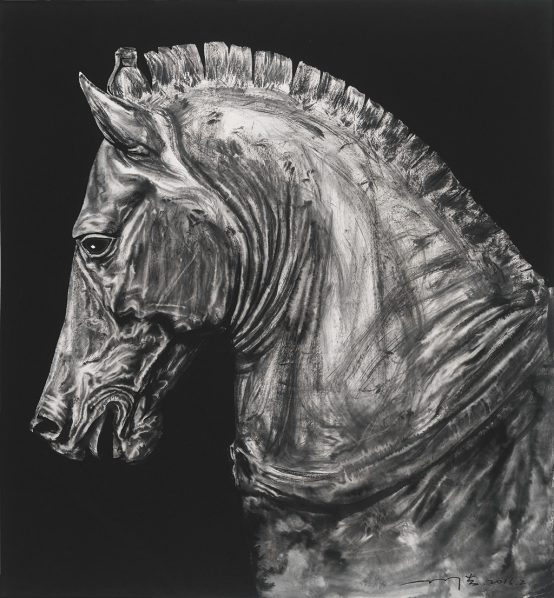
Sun Hao, Portrait of the Horse No.2, 2016; Ink on paper, 97x90cm
The import of the horse as spiritual self-portrait goes without saying. The artist draws from old tradition in imbuing other objects with his spirit and emotions, giving us another glimpse of the classical poet inside. In both Chinese and Western history, the “horse” is a symbol of strong will. The muscle lines on the horse’s neck undergo rich changes that are highly reminiscent of human body language. The movements gracefully convey a range of sentiments, from great ambitions to age and experience. Chinese art places great emphasis on the eyes. If we believe that the gaze is a channel for the meeting of minds, then what appears to be a depiction of the eyes of a horse is actually an expression of the same inner spirit. In Sun Hao’s works, there are subtle metaphors and tangled relationships, but also very direct language. For instance, the horse’s ear is not rendered in a completely realistic manner. Instead, it is small and sharp, like a small knife, and standing straight up, conveying a sense of urgency. The horse’s energy is like a bell ringing against the ear, like the moment of surprise when a drop of ink hits the paper. As Sun Hao says, “This represents a warrior spirit in his heart.”
When we first see Sun Hao’s works, we notice that there is none of the flashy contemporary abstract style. They evoke the famous straightforward, masculine image of men from Shandong Province, in that the realist style and solid forms are devoid of any unnecessary embellishments, their visual impact deriving entirely from heavy ink brushwork. Both painting and sculpture are exploratory languages of the structure of shape from Western art, and drawing is a base material for painting. The base of Eastern art is calligraphy, with the structure arising from brush and ink. As a medium for writing and painting, ink is a material, but more importantly, it is a language. These various forms come together in a complex set of overlapping relationships as Sun Hao re-creates the texture of marble sculpture in ink in works that also possess the contours and colors of drawing. In a game of material and properties, the artist explores the expanding boundaries and limits of ink and the serendipitous, uncontrollable, expansive and creative aspects of ink painting, while discovering the effects that emerge from painting sculpture. This is no longer a mere question of carrier; it now encompasses the independent capabilities of ink painting techniques as artistic language. Using technique as the path and entry point to conception, Sun Hao has found the physical appearance of his spiritual pursuits in ink.
This exhibition will continues to July 17th.

Sun Hao, Glacier, 2016; Ink on paper, 140x193cm
About the artist
Sun Hao
1980 Born in Linyi City, Shandong Province
2001 Graduated from the Chinese Traditional Paintings Department of Luxun
Academy of Fine Arts as an undergraduate, majoring in portraits painting.
2005 Graduated from the Chinese Painting Department of Central Academy of
Fine Arts as a master, majoring in materials and expression.
Currently for the Beijing Institute of Graphic Design Art Institute of experimental art professional teachers.
Courtesy of the artists and Amy Li Gallery.




























